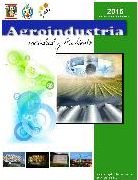Physicochemical and microbiological behavior of a bioreactor during acclimatization of the granularbiomass using tannery wastewater
Keywords:
acclimation, granular biomass, tannery effluent, COD, heterotrophic bacteria.Abstract
The tanning industry is among the most problematic from an environmental point of view, because it generates abundant effluents with high organic load , high electrical conductivity and heavy metals such as chromium. In this research, the physicochemical and microbiological behavior of a reactor load was studied during acclimatization of the granular biomass to the tannery wastewater. A reactor was used with a working volume of 2 L operated under aerobic conditions during cycles of 24-hour. The study was conducted in six phases, in which the concentration of the effluent from the tannery was gradually increased. COD and counting heterotrophic microorganisms were the main variables studied during the research. When removal of COD was stable and sedimentation of biomass occurred in the set time (≤ 2 min) then the condition was changed to the next phase. When the concentration of the tannery effluent increased then the removal efficiency of COD and heterotrophic bacterial count decreased; however, there was established a population of microorganisms capable of developing metabolic processes despite inhibiting compounds and poorly biodegradable organic matter present in the tannery effluent. Finally, biodegradable COD removal was 57.90% for tCOD and 76.80% for sCOD.
Downloads
References
Arrojo, B.; Vásquez, J.; Figueroa, M.; Mosquera, A.; Campos, J.; Méndez, R. (2007). Reactores de biomasa granular: más capacidad menos espacio. Artículos Técnicos Universidad de Santiago de Compostela.
APHA-AWWA-WEF (2005) Standard methods for examination of water and wastewater. 20ª ed. American Public Health Association. Nueva York, EEUU. 1427pp.
Buitrón, G. y Moreno, J. (2004). Modeling of the acclimation/deacclimation processes of a mixed culture degrading 4-chlorophenol. Water Science and Technology, 49 (1), 79-86.
Durai, G.; Rajasimman, M. (2011) Biological Treatment of Tannery Wastewater – A Review. Journal of Environmental Science and Technology 4 (1): 1-17. 2011.
El-Sheikh, M.A.S. (2009). Tannery wastewater pre-treatment. Water Science and Technology-WST, 60(2):433-440.
Farabegoli, G.; Caruccí, A.; Majone, M.; Rolle, E. (2004). Biological treatment of tannery wastewater in the presence of chromium. Journal of Environmental Management, 71(4):345–349.
Ganesh, R.; Balaji, G.; Ramanujam, A. (2006). Biodegradation of tannery wastewater using sequencing batch reactor – Respirometric assessment. Bioresource Technology, 97 (15): 1815-1821.
Orhon, D.; Genceli, E.; Cokgör, E. (1999). Characterization and modelling of activated sludge for tannery wastewater. Wáter Environment Research, 71(1):50-63.
Pire-Sierra, M.C.; Rodríguez, K.; Fuenmayor, M.; Fuenmayor, Y.; Acevedo, H.; Carrasquero, S.; Díaz, A. (2011). Biodegradabilidad de las diferentes fracciones de agua residual producidas en una tenería. Revista científica, Ciencia e ingeniería Neogranadina vol. 21-2PP.
Pire-Sierra, M.C., López-Palau, S., Dosta, J., Mata-Alvarez, J. (2012). Biological treatment of tannery wastewater using a sequencing batch reactor with granular biomass. Ecotechnologies for wastewater treatment. Santiago de Compostela, 25 al 27 de junio de 2012.
Pire-Sierra, M.C. (2012). Remoción de nutrientes en aguas residuales de una tenería aplicando tratamiento biológico y fisicoquímico. Tesis doctoral presentada en la Universidad del Zulia. Venezuela. 307 p.
Pozo, M. (2008). Proceso de nitrificación en reactores secuenciales discontinuos SBR (Sequencing batch reactor) con biomasa granular. Tesis. Escuel
Insel, H., Görgün, E., Artan, N., Orhon, D. (2009). Model based optimization of nitrogen removal in a full scale activated sludge plant. Environmental Engineering Science 26(3):471-479.
Karahan Ö., Dogruel S., Dulekgurgen E., and Orhon D. (2008). COD fractionation of tannery wastewaters – Particle size distribution, biodegradability and modeling. In: Water Research 42, 1083-1092.
Kreuk, M.K.; McSwain, B..S.; Bathe, S.; Tay, S.T.; Schwarzenbeck, Wilderer, P.A. (2005). Discussion outcmes Ede in: Aerobic Granular Sluge. Water and Enviromental Management Series, IWA Publishing, Munich. 162-169.
Lefebvre, O.; Vasudevan, N.; Torrijos, M.; Thanasekaran, K.; Moletta, R. (2005). Halophilic biological treatment of tannery soaks liquor in a sequencing batch reactor. Water Research, 39(2005):1471–1480.
López-Palau, S.; Dosta, J.; Pericas, A.; Mata-Alvarez, J. (2011) Partial nitrification of sludge reject wáter using suspended and granular biomass. Research Article.
Mace, S.; Mata-Álvarez J. (2002). Utilization of SBR technology for wastewater treatment: an overview. Industrial & Engineering Chemistry Research, 41:5539-5553.
Published
How to Cite
Issue
Section

This work is licensed under a Creative Commons Attribution-NonCommercial-ShareAlike 4.0 International License.




